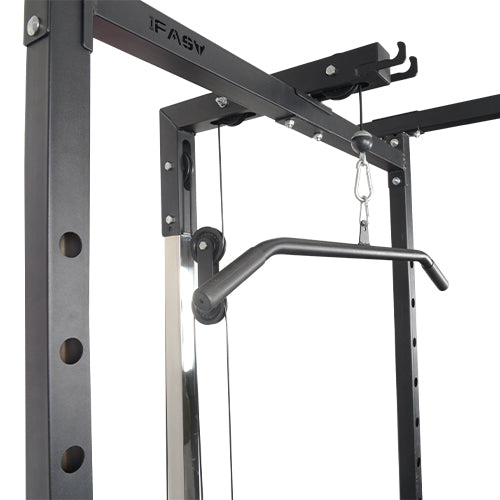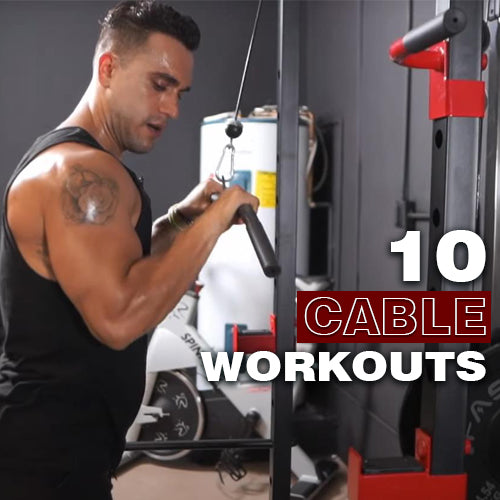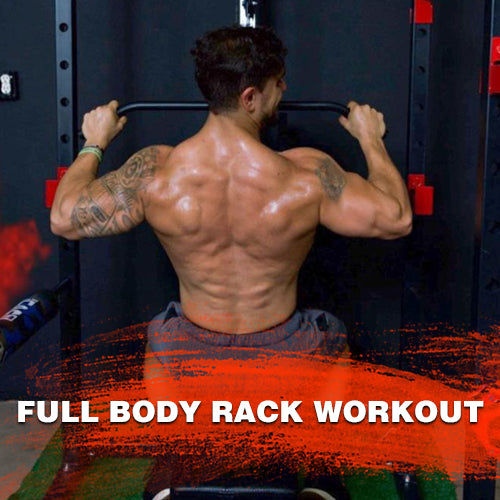The power rack or squat rack is prevalent fitness equipment, and it is also the core of building a home gym, because it can almost exercise the muscles of the whole body. Lower chest, triceps, biceps, core, glutes, and outer thighs. It also has many associated gadgets, such as ropes, straight bars, curved bars, etc.
In general, the great thing about power racks is their versatility. When starting at a home gym, you can buy a basic rack, but over time you can gradually add accessories and build a high-end training facility.
In this guide, we'll walk you through the different power rack attachments and how to use them.
Every squat rack should have the following accessories, with few exceptions.
Here will introduce 5 power rack attachments:
- Dip Bar
- Pull-up bar
- LAT pulldown attachment
- J-Hooks
- Safety bars
5 Best IFAST Power Rack Attachments
Dip Bar: Muscles Worked, Technique, Benefits

Dips Muscles Worked
Dips mainly exercise the chest muscles, triceps and deltoid muscles (front beam), latissimus dorsi, trapezius muscles, etc. The equipment required is the best dip bars. If the initial practitioners have poor strength, they can choose living furniture such as a weight bench and take the same action (because the foot on the ground can reduce the weight load).
How to do dips

Hold the bar with both hands, support the two arms on the parallel bars, keep the head straight on the chest and shoulders, the torso and upper limbs are perpendicular to the dip bars, and the lower legs overlap the ankle joints of the two feet after bending the knees. Slowly turn the elbows and curl the shoulders simultaneously so that the body gradually lowers to the lowest position. Pause for a moment, and lift both arms to restore.

Benefits of dips
Many studies can prove that closed-chain movements benefit muscle stimulation, distal fixation, and training of your body, such as squats, compared to inverted kicks. Actions and dips are the same. Dips can stimulate more muscles. At the same time, because they maintain a good balance, they are also suitable for core exercises.
In addition, high reps and low reps are applicable. Many exercises are heavy and low reps, but dips are rarely suitable for all rep ranges, and it is also a very suitable warm-up exercise.
Pull-up bar: Muscles Worked, Technique, Benefits

Pull-up muscles worked
The pull-up mainly exercises the upper limb muscles, mainly including the latissimus dorsi, biceps, and forearm muscles of the back. It also has a specific training effect on many small muscle groups around the scapula and forearm muscles. It can also be stretched to a certain extent. to the pectoralis major and shoulder deltoid.
Pull-ups are a classic exercise for back muscles and come in various forms. Different grip distances, methods, and training parts are also different. By changing the grip distance and grip method of the hand, the difficulty of pull-ups can be changed, and the muscles of different parts can be stimulated.
How to use a pull up bar

1.Appropriate grasp the pull-up bar with the palms forward.
Note when grasping: the distance between the hands is more than shoulder width when holding a wide grip; the distance between hands is shoulder width when having a middle grip. The distance between the hands is less than shoulder width in a close grip.
2.Straighten your arms in front, grasp the bar, lean your body back 30 degrees, keep your body straight, bend your lower back, and keep your chest out. This is where the action starts.
3.Pull your shoulders and upper arms back and down, bringing your body up until the bar touches your upper chest. Exhale while doing part of the exercise.
Tip: Concentrate on contracting your back muscles as you reach full tension. The upper torso should remain stationary while moving, with only the arms moving. The forearm should only grasp the bar, with no other movement.
4.After 1 second in the tightening state, begin to inhale. Slowly lower the body back to the starting state, allowing the arms to straighten fully and the latissimus dorsi to extend fully.
Benefits of pull up
- It can strengthen the muscles of the back. The pull-up is one of the most classic and effective back training methods. It has a very significant effect on the back. Stimulating the back and insisting on pull-up training can significantly increase the muscle volume of the arm, enhance the muscle strength of the back, and course, strengthen the muscles of the arm.
- The main force-generating parts of the pull-up are the back and arms. Therefore, in addition to strengthening the back muscles, the strengthening of the arm training is also very obvious. If you want to improve the arms training, you can use the reverse grip and narrow-gap grip. Allows for greater arm engagement.
- It can help you lose weight. Pull-ups strengthen muscles and improve basal metabolism, thereby increasing daily calorie consumption, so it can also help lose weight. In addition, it is helpful for the health of the spine. Pull-ups can not only correct the spine's position but also change the bad posture such as mild scoliosis, hunchback, and chest. It also has a significant therapeutic effect on mild lumbar disc herniation, neck and shoulder pain, etc.
LAT pulldown attachment

Lat pulldown is one of the most classic and popular compounds back exercises; it mainly targets training and strengthening the latissimus dorsi, thereby extending the width of the back and creating a sexy body with a wide back and a narrow waist. At the same time, it can also stimulate the trapezius, rhomboid, and biceps muscles of the back to a certain extent, which also has a particularly positive sign for the overall upper limb shape and strength improvement.

LAT pulldown attachments vary by brand, but they are usually offered as a pulley system that enables the use of both the lat pulldown and the low row with the attachment.
Add your bumper plates to the weight pegs, set the pulley system to your desired position, grab the Latitude drop bar, and get to work.

Learn More: How to do LAT pulldown
Close grip Vs Wide grip LAT pulldown
J-Hooks

The J-hooks are the little hooks on the squat rack post—you guessed it.
They come in various hook shapes, but they generally all have the same function: to hold the bar while loading and unloading it.
They also keep the bar high off the ground so that you can walk under the bar and squat directly instead of picking it up off the floor and placing it behind your shoulders in some way (which is possible, and there are tricks to do this, but they come with their significant risks).

How to adjust J-Hook
To move the hook:
- Twist the hook outwards.
- pull it out
- move it where you want
- Horizontal insertion hook
- twist down and into place
Safety bars (Safety pins)

Safety pins are horizontal bars you slide over or spin onto a post.
They are designed to catch the bar when you fail to lift. Safety pins can also be used as ad hoc J-hooks by setting them at the height corresponding to where you want to start the lift, but that's not their primary function.

At the end of the day, they should be your last line of defense against barbell drops. Even if you have to drop the weight, the bar will not hit and damage the floor, the lifting equipment and your self-esteem.
More Power Rack Guides
Full body power rack home gym workout
IFAST Home Gym Package
Click and shop home gym packages👉here



